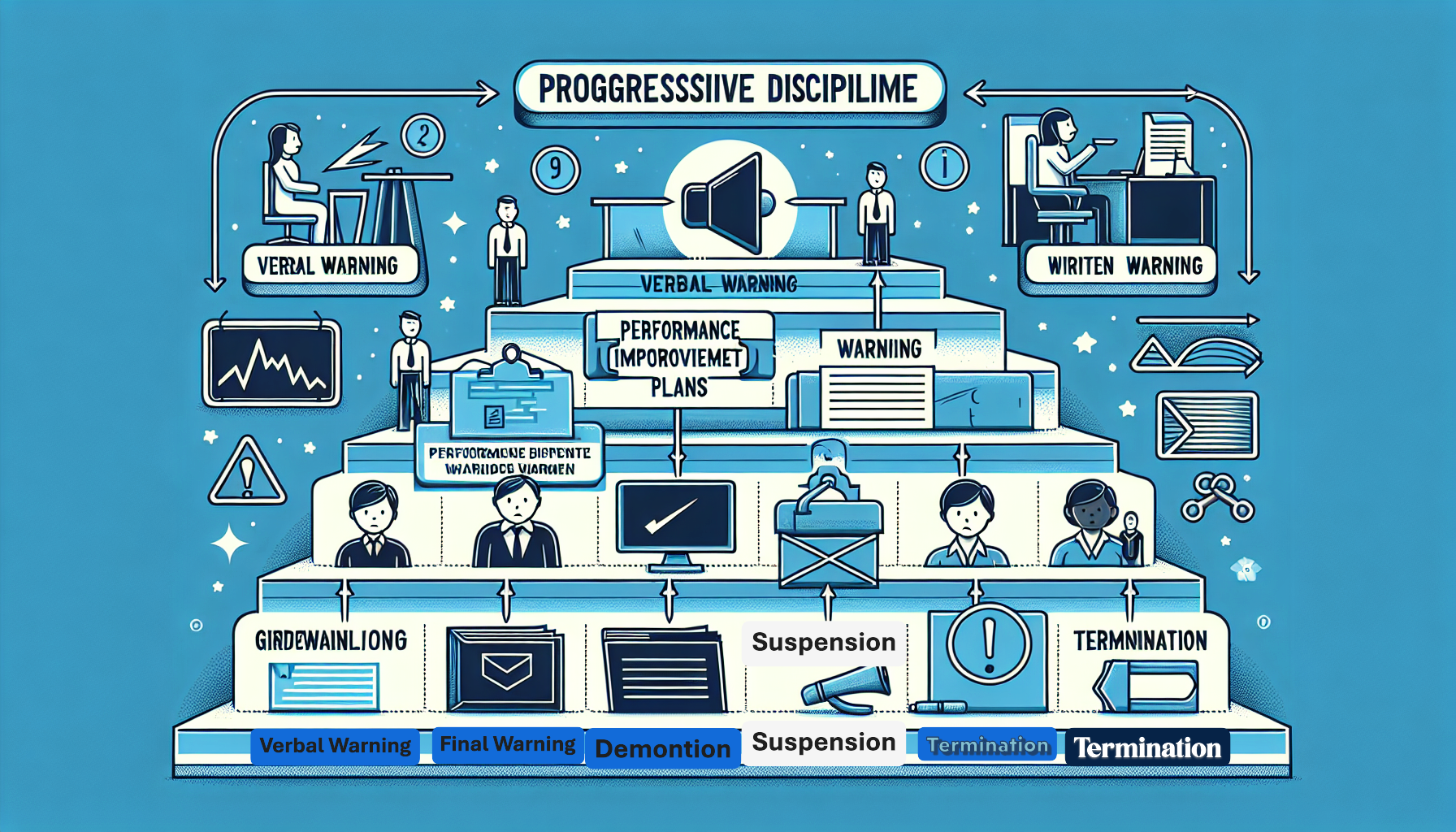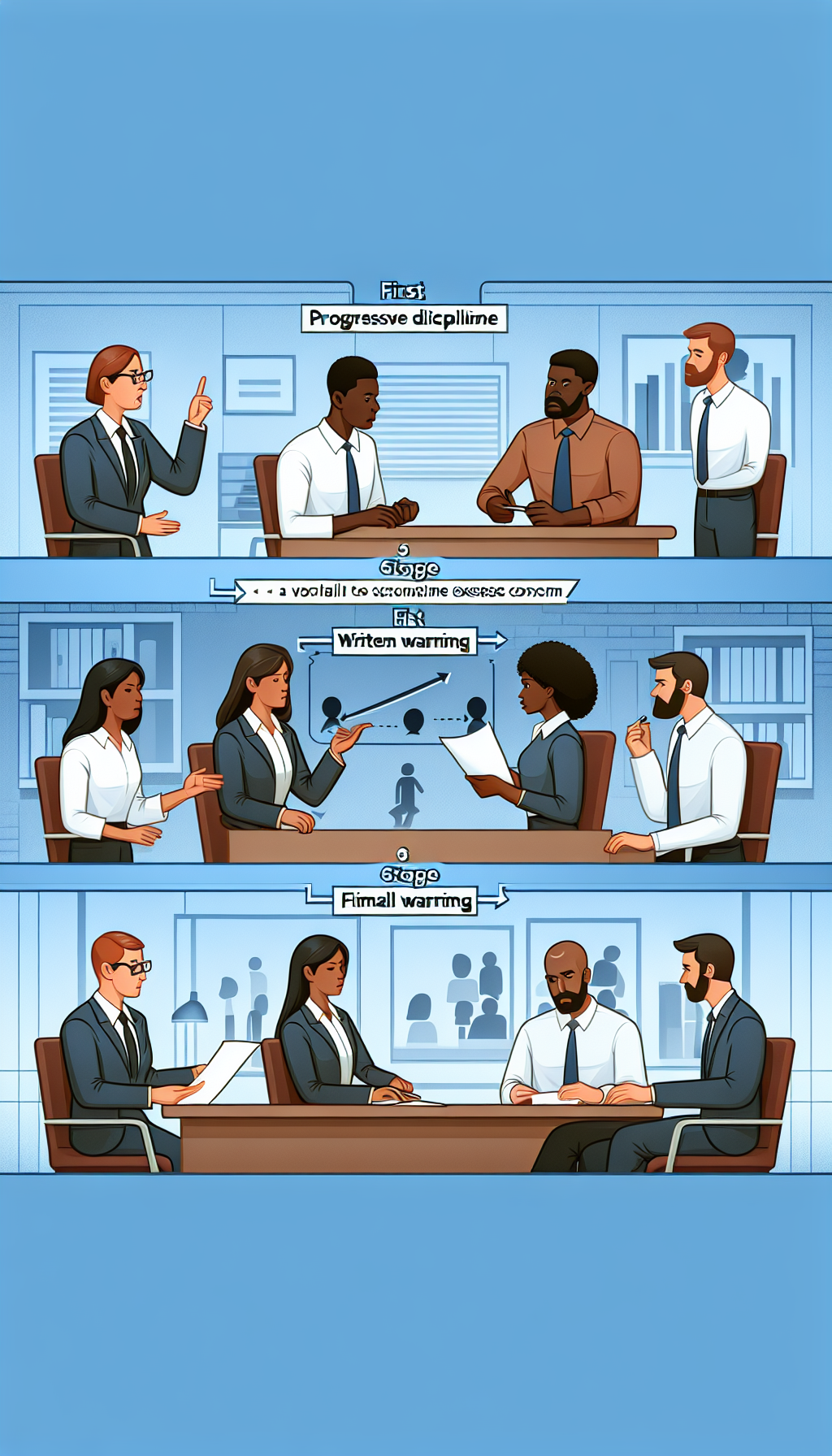The 7 Steps of Progressive Discipline: A Guide to Fair and
Effective Employee Management

Maintaining a productive and harmonious workplace requires clear expectations and a consistent approach to addressing employee performance or conduct issues. One of the most effective methods for achieving this is through the utilization of the 7 steps of progressive discipline. This system provides a structured framework for addressing problems, offering employees opportunities to improve while protecting the organization from further disruption. This article will delve into the 7 steps of progressive discipline, providing a comprehensive guide to implementing this system fairly and effectively.
Progressive discipline is a process that involves a series of increasingly severe penalties for repeated or significant violations of workplace rules or performance standards. The goal is not simply to punish employees, but rather to correct behavior, improve performance, and ultimately retain valuable members of the team. It emphasizes communication, documentation, and fairness, ensuring that employees are aware of expectations and given ample opportunity to meet them.
The 7 steps of progressive discipline provide a roadmap for managers and HR professionals to follow, ensuring consistency and minimizing potential legal challenges. Each step builds upon the previous one, creating a clear record of the employee's performance and the organization's efforts to address it. Understanding these steps is crucial for any organization committed to fostering a positive and productive work environment.
Here's a Breakdown of the 7 Steps of Progressive Discipline

Step 1: Verbal Warning
The first step in progressive discipline is a verbal warning. This is typically used for minor infractions or performance issues that need immediate attention. The purpose of a verbal warning is to bring the issue to the employee's attention, explain the desired behavior or performance standard, and provide an opportunity for correction.
Key elements of a verbal warning include:
Private Conversation: The discussion should take place in a private setting to avoid embarrassment or humiliation for the employee.
Specific Examples: Clearly and concisely explain the specific behavior or performance issue that needs to be addressed. Avoid vague generalizations and provide concrete examples.
Clear Expectations: Clearly communicate the expected behavior or performance standard. Ensure the employee understands what is expected of them.
Opportunity for Explanation: Allow the employee to explain their perspective and provide any relevant information. Listen attentively and consider their input.
Positive Reinforcement: Express confidence in the employee's ability to improve and offer support.
Documentation: While it's a verbal warning, it's still crucial to document the conversation. This should include the date, time, individuals involved, a summary of the discussion, and the agreed-upon expectations. The documentation should be kept in a confidential file, though it may not be formally placed in the employee's personnel file at this stage.
Step 2: Written Warning
If the behavior or performance issue persists despite the verbal warning, the next step is a written warning. This is a more formal step that documents the issue and the consequences of further violations.
Key elements of a written warning include:
Formal Document: The written warning should be a formal document, clearly stating that it is a written warning.
Detailed Description: Provide a detailed description of the specific behavior or performance issue, including dates, times, and relevant details.
Reference to Previous Warning: Reference the previous verbal warning and explain that the issue has not been resolved.
Clear Expectations: Again, clearly communicate the expected behavior or performance standard.
Consequences of Further Violations: Clearly state the consequences of further violations, such as suspension, demotion, or termination.
Employee Acknowledgement: Include a space for the employee to acknowledge receipt of the written warning. While they may not agree with the warning, their signature confirms they have received and reviewed it.
Documentation: Keep a copy of the written warning in the employee's personnel file.
Step 3: Suspension
A suspension is a temporary removal of the employee from the workplace, usually without pay. This step is typically used for more serious violations or when previous warnings have been ineffective.
Key elements of a suspension include:
Written Notification: Provide the employee with a written notification of the suspension, outlining the reasons for the suspension, the duration of the suspension, and any conditions for returning to work.
Clear Explanation: Clearly explain the specific behavior or performance issue that led to the suspension.
Review of Expectations: Reiterate the expected behavior or performance standards.
Documentation: Document the suspension in the employee's personnel file. This should include the date, time, individuals involved, a summary of the discussion, and the terms of the suspension.
Step 4: Final Written Warning
A final written warning is a serious step that indicates the employee is on the verge of termination. It is typically used when previous disciplinary actions have not resulted in sustained improvement.
Key elements of a final written warning include:
Formal Document: The document should explicitly state that it is a "Final Written Warning."
Comprehensive Review: The warning should comprehensively review all prior disciplinary actions taken, including dates, details, and the results of each action.
Clear Expectations: Reiterate the expected behavior or performance standards in a clear and concise manner.
Consequences of Failure: Clearly state that any further violations will result in immediate termination.
Opportunity for Improvement: While emphasizing the seriousness of the situation, offer one last opportunity for the employee to demonstrate improvement.
Employee Acknowledgement: Include a space for the employee to acknowledge receipt and review.
Documentation: Place a copy of the final written warning in the employee's personnel file.
Step 5: Demotion
Demotion involves moving an employee to a lower-level position with reduced responsibilities and pay. This is a less common step, but it can be appropriate in situations where the employee is struggling to meet the demands of their current role but possesses valuable skills and experience that could be utilized in a different capacity.
Key elements of a demotion include:
Written Notification: Provide the employee with a written notification outlining the reasons for the demotion, the new position, the new salary, and the effective date of the change.
Clear Explanation: Clearly explain the reasons for the demotion, focusing on the performance issues that led to the decision.
Support and Training: Offer support and training to help the employee succeed in their new role.
Documentation: Document the demotion in the employee's personnel file.
Step 6: Performance Improvement Plan (PIP)
While often implemented prior to a final written warning, a Performance Improvement Plan (PIP) can also fall within the progressive discipline framework. A PIP is a structured plan designed to help an employee improve their performance to meet specific goals and expectations.
Key elements of a PIP include:
Specific Goals: Clearly define the specific performance goals that the employee needs to achieve.
Actionable Steps: Outline the specific actions the employee needs to take to achieve those goals.
Timeline: Establish a clear timeline for achieving the goals.
Regular Feedback: Provide regular feedback to the employee on their progress.
Support and Resources: Offer support and resources to help the employee succeed.
Consequences of Failure: Clearly state the consequences of failing to meet the goals, which could include further disciplinary action, up to and including termination.
Documentation: Document the PIP and all progress updates in the employee's personnel file.
Step 7: Termination
Termination is the final step in progressive discipline and should only be used as a last resort when all other efforts to correct the employee's behavior or performance have failed. It involves ending the employee's employment with the organization.
Key elements of termination include:
Legal Compliance: Ensure that the termination complies with all applicable laws and regulations.
Documentation Review: Thoroughly review all documentation related to the employee's performance and disciplinary history.
Consistent Application: Ensure that the termination is consistent with how other employees have been treated in similar situations.
Professional Delivery: Deliver the termination message in a professional and respectful manner.
Clear Explanation: Clearly explain the reasons for the termination.
Final Pay and Benefits: Provide the employee with information about their final pay, benefits, and any other relevant information.
Documentation: Document the termination in the employee's personnel file.
Conclusion

The 7 steps of progressive discipline provide a structured and fair approach to addressing employee performance or conduct issues. By following these steps, organizations can ensure that employees are given ample opportunity to improve while protecting the organization from potential legal challenges. While the specific steps and policies may vary depending on the organization's size, industry, and legal requirements, the underlying principles of communication, documentation, and fairness remain paramount. Implementing a well-defined and consistently applying the 7 steps of progressive discipline system is essential for creating a productive, respectful, and legally compliant workplace.